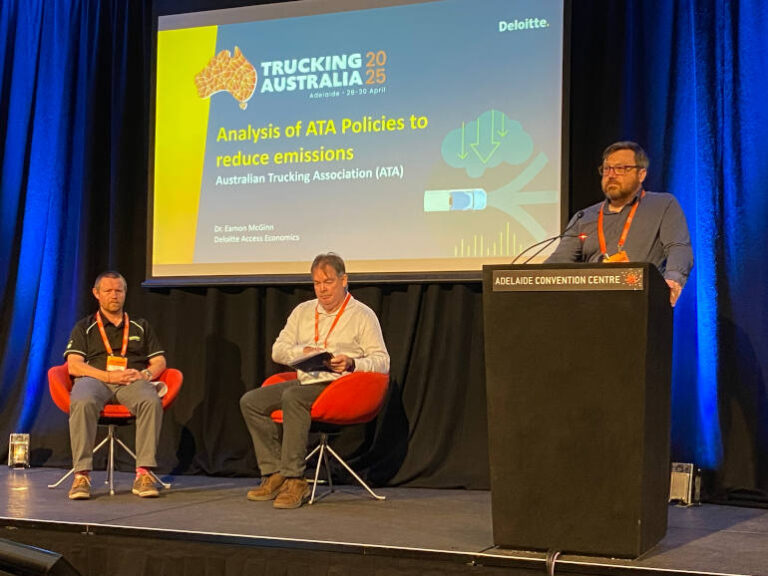The Australian Trucking Association (ATA) has taken a practical and data-led approach to decarbonising the trucking industry with a new analysis by Deloitte Access Economics Partner Eamon McGinn. In a session at the Trucking Australia 2025 conference, McGinn detailed the findings of Deloitte’s modelling, which assesses three key policies from the ATA’s election platform to estimate their likely impact on emissions from the heavy vehicle sector.
“These aren’t our recommendations to the industry,” McGinn explained. “Our role was to quantify what the ATA is proposing so that when the industry goes to government, they can talk about what’s possible — and back it up with numbers.”
Three Policies, One Goal: Cut Emissions
The analysis focused on three targeted initiatives:
- A Purchase Voucher Scheme – Providing a 50% subsidy to bridge the cost gap between electric trucks and conventional diesel trucks.
- Incentives for Renewable Diesel – Introducing a 5% synthetic diesel blend into the fuel mix by 2036.
- Targeted Road Access Upgrades – Investing $5 billion in road projects and policy changes to improve access for high productivity vehicles (HPVs).
According to McGinn, these policies are expected to reduce emissions by 35 million tonnes of CO₂ over 25 years, equating to a 9% drop compared to business-as-usual projections.
Voucher Scheme Accelerates Urban Truck Electrification
Battery-electric trucks are significantly more expensive than diesel equivalents — especially for articulated trucks, where the price gap could remain until 2050. Deloitte found the ATA’s 50% subsidy could advance electrification in rigid trucks (commonly used in urban areas), achieving 20% market share in that segment by the early 2030s. The voucher would cut 15 million tonnes of CO₂, with 80% of those savings from rigid trucks.
“Electrification of rigid trucks makes sense — they do shorter hauls, return to base, and operate in urban areas where EV infrastructure is easier to deploy,” McGinn said.
Renewable Diesel: Bridging to 2040
The second pillar introduces a 5% renewable diesel mandate from 2036, aimed primarily at articulated trucks where electrification lags. This “drop-in” solution, already supported by new Australian fuel standards, could cut emissions by 7 million tonnes — mostly from articulated trucks.
“This policy targets that transition period in the late 2030s before hydrogen or electric powertrains reach scale,” McGinn explained.
The benefit is twofold: no infrastructure overhaul is needed, and renewable diesel helps meet near-term reduction goals without displacing existing fleets. However, challenges remain around feedstock availability and competition with aviation biofuels.
Upgrading Roads to Unlock Productivity Gains
The third policy focuses on increasing the share of HPVs by improving road infrastructure and liberalising concessional mass limits. Deloitte estimates that over 25 years, improved access and payload efficiency would cut emissions by 14 million tonnes — with most savings from articulated HPVs.
“These upgrades mean fewer trucks and fewer kilometres to move the same freight,” McGinn said. “That’s real emissions impact.”
Timing Is Everything
The analysis shows most gains from these policies would occur in the 2030s — before broader technology shifts, like hydrogen trucking, are expected to ramp up from 2040.
“The value in these policies is that they address the emissions gap in the 2030s, a decade where current modelling shows little progress,” said McGinn.
Deloitte’s forecast aligns with CSIRO and AEMO projections, showing emissions from trucking rising until the early 2030s due to growing freight demand, then falling sharply as zero-emission technologies gain traction.
A Platform for Practical Action
While a 9% emissions reduction may seem modest compared to Australia’s overall net zero target, the ATA’s platform demonstrates that practical, industry-supported policies can make meaningful contributions. The platform doesn’t aim to “solve everything,” but to make realistic progress — and the modelling proves that’s achievable.
“This is the sort of leadership we need from a national association,” said Cam Dumesny in closing. “The ATA isn’t just talking about decarbonisation — it’s showing how the industry can lead the way.”






